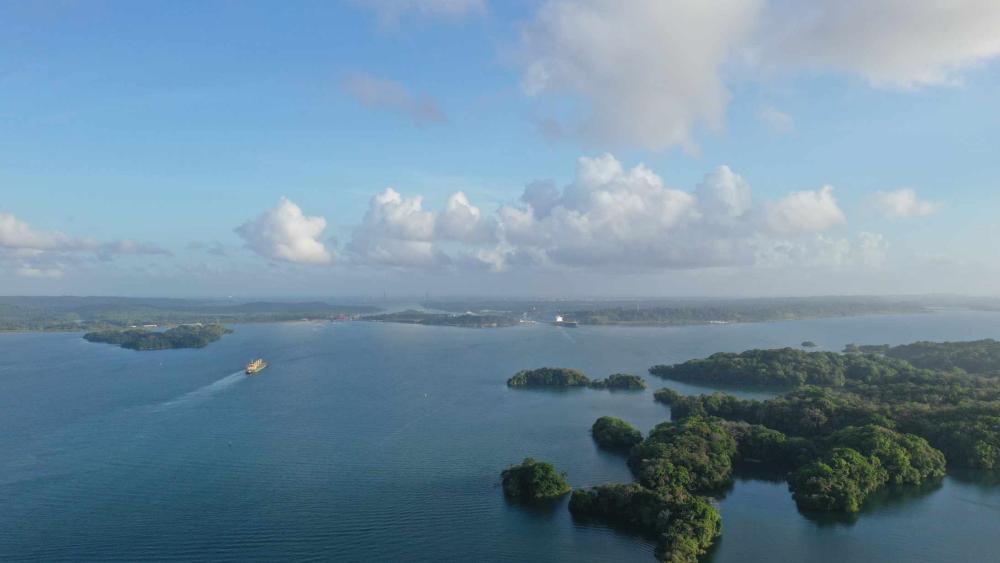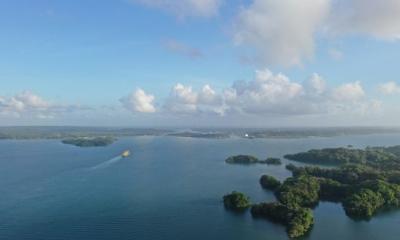
Atlantic Canal entrance from Lake Gatun. | Photo: Gustavo A. Castellanos-Galindo
Maritime shipping is one of the most important introduction pathways for invasive species. Historically, species introductions through the Panama Canal have been relatively low, largely due to the existence of a soft barrier – the freshwater artificial Lake Gatun –inside the Canal. However, the 2016 expansion of the Panama Canal involved major structural changes to the canal’s lock system, which may have increased the likelihood that more marine fish species and greater numbers of them enter the lake and eventually cross the canal. This is because the new locks for the passage of mega-ships (called Neopanamax) are substantially larger than the old ones. So for every ship transit through the new locks, more freshwater flows into the sea, but also more seawater enters Lake Gatun – and therefore potentially more marine fishes.
The research team compared the fish populations before (2013-2016) and after (2019-2023) the expansion of the canal. They used a unique long-term series of scientific standardized catch data on the number, biomass and spatial distribution of the fish community. "The Panama Canal has the potential to connect the marine biota of the Atlantic and Pacific Oceans, which have been separated for three million years. Before the canal’s expansion, this potential was relatively low. Now it looks that the permeability of the canal to interoceanic invasions is increasing after its expansion”, said Gustavo A. Castellanos-Galindo. He is one of the two lead authors of the study and a researcher at IGB, FU Berlin and the Smithsonian Tropical Research Institute.
After the canal expansion: the proportion of marine fish species in total mass increased from 26 to 76 percent
Since 2016, the composition of the fish community in Lake Gatun has significantly shifted from freshwater to marine fish species. Before the canal’s expansion, marine fishes made up only 26 percent of the total fish biomass; now they account for 76 percent. Of these species, 18 are originally from the Atlantic and five from the Pacific. Prior to 2016, around 57 percent of the biomass of the lake's fish community consisted of non-native freshwater fishes, particularly the Peacock Bass (Cichla ocellaris var. monoculus) and the Nile Tilapia (Oreochromis niloticus), while native freshwater fishes made up 17 percent. After the expansion, native and non-native freshwater fish species make up only 11 and 13 percent of the total fish biomass, respectively.
Large predatory fishes from the ocean change the food web and thus the fish stocks for local fisheries
The researchers also looked at functional groups. These are groups of fish species that use environmental ressources in a similar way. With this approachd, the impact of the altered fish community on the ecosystem can be better assessed. The team found 15 new functional groups in the fish community of Lake Gatun following the canal’s expansion. The most representative group (by weight) are large pelagic predators, such as the Atlantic Tarpon (Megalops atlanticus). Conversely, eight groups from the pre-enlargement period are missing: they correspond mainly to native freshwater fish species, mostly small in size, that feed on detritus or are omnivores, for example Brycon petrosus. "The food web in Lake Gatun is being severely altered by the novel marine fish species. This has also important impacts on local fisheries", said Prof. Jonathan Jeschke, co-author of the study and researcher at IGB and FU Berlin.
Risk of interoceanic invasions
The researchers also investigated the risk that these changes pose for possible interoceanic migrations. “The increase in marine organisms in this water corridor could represent a potential invasion in progress, increasing the likelihood that some species will pass through the canal and colonize the opposite ocean. Since most of these marine fish are apex predators with a broad niche range, their colonization of the Atlantic and Pacific is likely to alter ecological interactions and possibly lead to ecosystem-level changes“, said Gustavo A. Castellanos-Galindo.

The Snook (Centropomus) is a marine predatory fish. | Photo Gustavo A. Castellanos-Galindo

The new locks are larger. | Photo: Gustavo A. Castellanos-Galindo

Big container ship in direction to the entrance of the Panama Canal. | Photo: Gustavo A. Castellanos-Galindo








